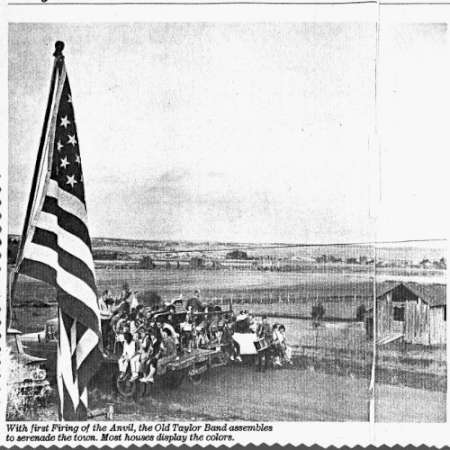- Holbrook
- Winslow
- Cowboys & Ranch Life
- Harvey Houses & Harvey Girls
- Historic Route 66
- Romance of the Railroad

Old Downtown
Pictured here is Holbrook’s downtown business district in the early 1900s. The photo was probably taken looking southwest from the depot. The railroad chose Holbrook to serve as a railhead for supplies traveling south to Fort Apache. The depot was built in 1882, two miles west of Horsehead Crossing. Present-day Holbrook grew up around the new railroad station.
Back in the 1880s, Holbrook was known as the “town too rough for women and churches.” This was in the heart of a lawless land. There were Mormon settlements to the south, the Navajo Reservation to the north, and huge cattle ranches east and west. The Santa Fe Railroad built through town and established their station about one block from the infamous “Bucket of Blood Saloon”.
Today you can find this depot just south of the railroad tracks on Navajo Blvd.
Photo used with permission of the Navajo County Historical Society Museum.
photo id: 66

Bucket of Blood Saloon
A famous landmark in Holbrook is the “Bucket of Blood” saloon. Originally called the “Cottage,” it was renamed after this incident as recalled by Albert E. Potter:
“Joe Crawford, a cowboy who had worked for the Hashknife outfit, and a gambler, George Bell, rode into the outfit’s camp, just west of Holbrook, where cattle were being held for shipment.”
“Crawford was badly shot up.” Bell said he and Crawford had been at the “Cottage”, playing cards with Ramon Lopez and his partner. A disagreement over the game resulted and Lopez struck Crawford over the head with his gun. Crawford drew his six-shooter and killed Lopez. After several shots were fired, he had also shot and killed Lopez’s partner.
Where the dead men had lain, enough blood stained the floor to have filled a bucket. It was renamed the “Bucket of Blood” soon after.”
Photo used with permission of the Navajo County Historical Society Museum.
photo id: 503

A & B Schuster General Store
The A. & B. Schuster Mercantile Company was one of the pioneering businesses of Holbrook. It was started in 1884 by Adolf Schuster and his twin brother Ben, who came from Bernalillo, New Mexico. A newspaper report stated that there “were scarcely a dozen structures in the business district” when the Schusters arrived to open their miscellaneous store in a little frame building on Main Street. A room at the rear served as their home.This store was completely destroyed in Holbrook’s first major blaze that wiped out most of the town’s business structures. In short order though, the commercial section was rebuilt using quarried stone and adobe bricks.
Photo used with permission of the Navajo County Historical Society Museum.
photo id: 62

Business in Holbrook
The Adamson and Burbage store, housed in a stone building by the railroad, was already in operation when the Schuster’s arrived. Holbrook then had a population of about 200. Despite the small number of people, there were three saloons, a jewelry store, a gunsmith shop, a blacksmith shop, a livery stable, a grocery and drug store, a meat market, and the two stores that sold general merchandise.
Francis M. Zuck was owner of the Holbrook House Hotel, Mrs. A. M. Boyer ran the Apache House Hotel, J. D. Houck ran the White House billiard hall, and Charley Lindenberger was the baker. Sing Lee was proprietor of the Chinese Laundry and Sam Kee ran a restaurant, which was only seven feet wide.
Photo used with permission of the Navajo County Historical Society Museum.
photo id: 506

The Schuster Family
A.B. Schuster and his wife (right), pose with Mrs. McCarty and her child and Bernard Schuster in the early 1900s.
Photo used with permission of the Navajo County Historical Society Museum.
photo id: 129

Hotel Holbrook
The Hotel Holbrook was built about 1900 by the Zuck Family. It stood on what is now Navajo Blvd., on the first block from the railroad crossing. Many years later the establishment included the Navajo Buffet and a bar, in which the famed painting with the two bullet holes from the Bucket of Blood Saloon hung. In its final years, Louis Turley operated his barber shop in the front portion of the building. Later he built a new shop, and the owner of the old hotel gave Louis the Bucket of Blood painting, before the hotel was torn down. Louis in turn donated the famed painting to the Navajo County Historical Society for the museum.
Photo used with permission of the Navajo County Historical Society Museum.
photo id: 61
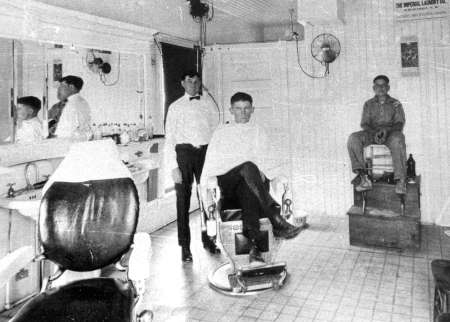
Holbrook’s First Barber Shop
This was an early barber shop in Holbrook. It is believed to be the barber shop inside Hotel Holbrook, though this is unconfirmed.
Photo used with permission of the Navajo County Historical Society Museum.
photo id: 64

Holbrook’s Blacksmith Shop
A blacksmith shop was located on the north side of the railroad tracks east of the Blevins House in the late 1880s.
Photo used with permission of the Navajo County Historical Society Museum.
photo id: 63

Dyer Store
Pop and Ma Dyer operated a small store for many years on Apache Drive just south of the Little Colorado River.
Photo used with permission of the Navajo County Historical Society Museum.
photo id: 136

H.H. Scorse Store
The H.H. Scorse store was a popular stop for early residents of Holbrook and the surrounding area to stock up on supplies.
Photo used with permission of the Navajo County Historical Society Museum.
photo id: 128

Interior of an Early Business
Stores were stocked amply with everything that a customer might desire, resulting in few empty spaces.
Generally there was one of these stores for large areas. People would travel from all over to get supplies.
Photo used with permission of the Navajo County Historical Society Museum.
photo id: 71

The Liberty Theater
Holbrook’s first movie theater, the Liberty, was located at the H.H. Scorse Trading Post.
In later years the Roxy Theater opened north of the trading post and then later relocated to a larger building on West Hopi Drive.
Photo used with permission of the Navajo County Historical Society Museum.
photo id: 79

The Liberty Theater
Another view of the Liberty Theater in Holbrook showing early automobiles lining the street of theater goers.
Photo used with permission of the Navajo County Historical Society Museum.
photo id: 505

Arizona Co-op
The original Arizona Co-op Mercantile Institute (ACMI) burned down during the famous fire of 1888. It was relocated on the west side of the A & B Schuster Store on Bucket of Blood Street.
ACMI was modeled after Zions Co-op at the Mormon Church headquarters. They allowed members to take advantage of lower prices by buying in bulk and sharing. They also allowed and encouraged locals to sell their products and goods there.
In later years the ACMI sold the building to Max and Adoulph Schuster, who then expanded his store and its line of merchandise. The ACMI store was another of Holbrook’s favorite gathering places in the early 1900s.
ACMI was also located in Woodruff for a period of time in the 1880s.
Photo used with permission of the Navajo County Historical Society Museum.
photo id: 68

Leavitt’s Garage
Chet Leavitt, from Massachusetts, came to Arizona in 1919 while trading with Native Americans. He opened Leavitt’s garage in 1922 and served motoring customers for many years. It was one of the most modern and well-equipped garages of its time.
Photo used with permission of the Navajo County Historical Society Museum.
photo id: 78

Burned business section
In addition to gunfights and brawling during the first years, Holbrook experienced severe floods and fires. The worst fire occurred on June 26, 1888 when a warehouse filled with wool burst into flames. Soon the flames were spreading from building to building. The fire fighting equipment was of a primitive nature and when the fire was finally subdued, nearly every business place in Holbrook was totally destroyed.
However, nothing could destroy the faith of the residents in the new town. As soon as the ashes cooled they began building again, this time with less flamable brick and adobe. The railroad depot had been burned with all its contents so a depot was one of the first new buildings erected. The second big fire did not occur until 1902 and by this time there was more equipment available and the immediate arrival of volunteer citizen fire fighters soon quelled the blaze. Very little damage resulted.
Photo used with permission of the Navajo County Historical Society Museum.
photo id: 504

Andy Blevins (Cooper)
Andy Blevins participated in the feud between the Graham and Tewksbury families. The feud lasted over a decade between the cattle-raising Grahams and the Tewksbury sheep farmers, and was referred to as the Pleasant Valley War or the Tonto Basin War. Blevins, also known as Andy Cooper, was a member of the Graham faction. In 1887, Blevins participated with other Graham family members in an ambush of a Tewksbury cabin near Young, AZ, in which John Tewksbury and William Jacobs were killed. Andy Blevins was heard later in a store in Holbrook bragging that he had killed them.
Pictured with Andy is his sister Lila.
Photo used with permission of the Navajo County Historical Society Museum.
photo id: 537

Blevins House
The Blevins House on the north side of the railroad tracks as it appeared around 1920. The home was the site of a shootout with Sheriff Commodore Perry Owens, who came to arrest one of the Blevins Boys, Andy Cooper for a cattle rustling. Cooper was actually Andy Blevins who changed his name when he came to Arizona because of an outstanding warrant for murder in Texas. When Owens went to the Blevins family home on September 4, 1887, the family was having Sunday dinner and Andy refused to come out. Instead his half-brother, John, opened the door and took a shot at the sheriff. Owens was able to draw both six-shooters and hit both John and Andy. A gunfight erupted and in less than a minute ended up with Andy, 15- year-old Sam Blevins and Mose Roberts, a friend of the Blevins, dead. John Blevins was wounded. Today the Blevins House is the home of the Holbrook Senior Center on Central Street in Holbrook.
Photo used with permission of the Navajo County Historical Society Museum.
photo id: 67

Sheriff Commodore Perry Owens
Into this lawless environment came Commodore Perry Owens, a young man with flowing blond hair and the reputation of being a dead shot. He was hired originally as foreman by the John Walker Ranch at Navajo Springs in 1881. He also held the job of range foreman for the Gus Zeiger outfit, and before that was guard of the cavalry horses held at Navajo Springs where they were in danger of being stolen. It is said that he killed so many Navajo Indians that he earned the name of “Iron Man”.
The Indians decided that he lived a charmed life and could not be killed. He was as good a shot with his left hand as with his right, wore twin forty-fives at his hips, and carried two rifles in his saddle scabbards. He shot from the hip and often got the drop on his opponent.
Photo used with permission of the Navajo County Historical Society Museum.
photo id: 496

Green Lantern Cafe
Nevert and Gilbert Scorse owned and operated the Green Lantern Cafe on Old Route 66 in Holbrook for many years. In fact, Gilbert’s family has been in business in the Holbrook area since the 1880s. Located just northwest of the depot, folks from neighboring communities on the rail line would ride over to Holbrook to have dinner and take the next train home.
Nevert and Gilbert were married for 58 years. Gilbert passed January 2001 and his wife, Nevert, in November of 2008. The white house that was the Green Lantern Cafe in 1937 still stands today.
Photo used with permission of the Navajo County Historical Society Museum.
photo id: 70

First Campbell’s Coffee Shop
This is the first Campbell’s Coffee House on Navajo Boulevard, on the north side of Hopi Drive in Holbrook. It served as a bus depot when bus transportation first took over for the stagecoaches. Campbell’s Coffee House of Holbrook was established in 1924 by Chester B. Campbell and was a landmark and popular eatery for many years. Located along Route 66, the business was the stopping point for many tour buses. A Santa Fe Trail Stages tour bus can be seen above, perhaps for a lunch of Campbell’s famed “son of gun” stew.
Photo used with permission of the Navajo County Historical Society Museum.
photo id: 65

Campbell’s Coffee House
Around 1940 Campbell’s Coffee House moved south of its original location on Navajo Blvd to the southeast corner of Hopi Drive and Navajo Blvd. The popular eating establishment was known for its endless cups of coffee and “son of gun” stew. Dick and Gladys Mester operated the business for more than 45 years. After closing the restaurant portion they continued to operate the bus depot, with Gladys finally retiring in the early 1990s.
Photo used with permission of the Navajo County Historical Society Museum.
photo id: 132

Courthouse Card
During the years between 1881 and 1895, a lively rivalry developed between the new towns of Holbrook and Winslow. When in 1895 Apache County was divided and the western section received the name Navajo, each town vied for the honor of being the county seat. The honor fell to Holbrook, that community having a majority of 162 votes.
Photo used with permission of the Navajo County Historical Society Museum.
photo id: 135

Pony Express Rider display
A Pony Express museum exhibit.
The Navajo County Sheriff’s Hashknife Posse was organized as a search and rescue group in 1955. Later they started their annual Pony Express Ride carrying official U.S. mail. They have held the longest continuous contract with the U.S. Postal Service to carry the mail to Scottsdale. In 2015, they celebrated their 57th ride.
Photo used with permission of the Navajo County Historical Society Museum.
photo id: 498

Holbrook’s First School
The first public school was erected in Holbrook in 1885. It was an adobe 25 by 45 foot building, and in the beginning twelve girls and fifteen boys were registered. Mr. German and Miss Estelle M. Hirstein were both teachers there. A total of 44 students enrolled for the 1893-1894 term.
One of the pupils was Lloyd C. Henning, who later became a leading citizen of Holbrook. The teacher mentioned in old reports was Miss Clara F. M. Laughlin.
Photo used with permission of the Navajo County Historical Society Museum.
photo id: 508

Color Guard
Over the decades, many parades in Holbrook proceeded down America’s Highway 66. Here, the American Legion Color Guard passes by the Navajo County Courthouse.
Photo used with permission of the Navajo County Historical Society Museum.
photo id: 133

Community Church of Holbrook
The Holbrook Community Church was constructed in 1912 and was the community’s church. Judge Sidney Sapp’s wife and friends said that the town should have a church and not just saloons so that more people would move there. Later this church became the United Methodist Church, which still uses the structure, though two or three additions have been added over the years.
Photo used with permission of the Navajo County Historical Society Museum.
photo id: 134

First Airplane to Land in Holbrook
Holbrook’s airport was open for business on March 1, 1943. It was a special day indeed when the first airplane landed at the new airport in Holbrook.
Photo used with permission of the Navajo County Historical Society Museum.
photo id: 137

Front Street
This is Front Street in Holbrook in the early 1900s. The street was on the south side of the railroad tracks. The view is looking west from Apache Drive.
Photo used with permission of the Navajo County Historical Society Museum.
photo id: 138
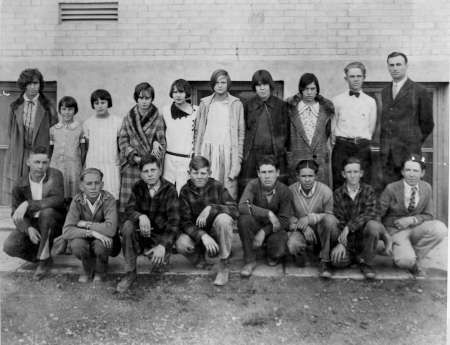
High School Picture
Students in front of the Old Main High School that was built in 1916.
Photo used with permission of the Navajo County Historical Society Museum.
photo id: 140

Arizona Rancho
The Arizona Rancho was constructed in the late 1800s as the Brunswick Hotel. The Aztec Land & Cattle Company’s Hashknife Outfit’s offices were located in the hotel. In later years the Taylor Family purchased the structure and added the wing of rooms on the left. The Arizona Rancho housed navel cadets who were training at the Holbrook Airport during World War II. it was an established youth hostel as well. Today the structure looks much like the above postcard, except it is abandoned and waiting to hopefully be restored to its former glory.
Photo used with permission of the Navajo County Historical Society Museum.
photo id: 142
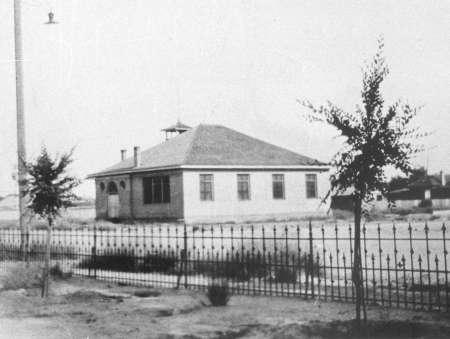
Sheldon Elementary School
The Sheldon Elementary School on West Arizona was built around 1912 to replace the one-room adobe brick schoolhouse .
Children in the early 1900s were supposed to go to school until the age of 16, however, most kids never finished the 8th grade. They went to work in factories, farms and coal mines to help their families. A few were able to go to high school and some of them managed to go to college. Mostly men went to college, as very few women were given the opportunity to go to college in those days.
Photo used with permission of the Navajo County Historical Society Museum.
photo id: 77

Holbrook’s Old Main High School
Holbrook’s Old Main High School was constructed in 1916, but by 1928 it was already adding expansion wings to serve an expanding student body.
Photo used with permission of the Navajo County Historical Society Museum.
photo id: 80
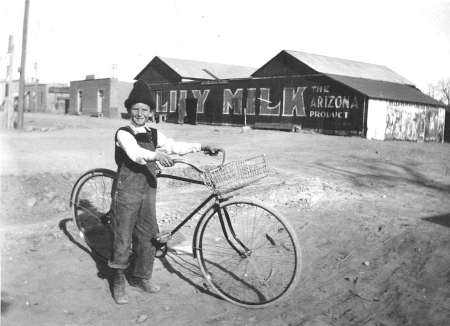
Jay Manley
Jay Manley was a mighty proud lad with his new bicycle.
Photo used with permission of the Navajo County Historical Society Museum.
photo id: 123

Old Still
Photo used with permission of the Navajo County Historical Society Museum.
photo id: 125

Melvina Cheney Fish
This photo of Melvina Cheney Fish was taken in Holbrook when her husband, John L. Fish, worked at the ACMI store. It is a reminder of the endless chores of a pioneer wife and mother in the days when water had to be heated on a wood stove and children had to take turns bathing, youngest first. L-R: Julia, Hamilton Murphy, Ambrose Marion (baby), and Melvina. (Fish Family Photo)
Melvina Cheney married John L. Fish in Pinedale when she was 15 and he was 20. Shortly after they were married, John and Melvina moved to Holbrook where he worked at the Arizona Cooperative Mercantile Institution (ACMI) store. They spent part of their summers in Pinedale so their seven children could enjoy the outdoors. On July 27, 1903, Melvina died at Pinedale, leaving John a widower with seven children to raise. His relatives cared for the children until he married Julia Tanner of Joseph City June 1, 1904. She raised Melvina’s seven children and had nine more with John. The family moved to Lakeside in 1906 where he bought a squatter’s right from Billy Scorse. He served as the first postmaster, and later bishop of the Lakeside LDS Ward.
photo id: 1116

Downtown Winslow
When this photo was taken in the 1920s at Second St. and Kinsey Ave., the street was a designated segment of the National Old Trails Highway. But as more and more people acquired automobiles in those days, there arose an urgent demand to tie together the segments of many highways into one interstate route. Eventually crossing eight states and covering over 2400 miles, Route 66 was officially dedicated on Nov. 11, 1926. Second Street was still a bit rough and dusty in this photo, but that was the case in most rural Arizona towns. Dagg Mercantile, on the far right, was an early Winslow business which thrived until the Depression days in the early 1930’s. They went out of business because they extended credit to too many people who were unable to pay.
Photo courtesy of the Old Trails Museum/Winslow Historical Society, www.OldTrailsMuseum.org.
photo id: 461

Winslow from the East
Winslow grew with the transfer of Santa Fe’s Division Headquarters from Gallop in 1897, bringing railroad employees and their families to establish a thriving community for the next 20 years.
Navajo County controlled Winslow, dominated by the railroads controlling land sales, maintenance of the town and the water supply. Local businesses began pushing for incorporation and over protest from the Santa Fe administration managed to get Navajo County Board of Supervisors to grant it in 1900.
Photo courtesy of the Old Trails Museum/Winslow Historical Society, www.OldTrailsMuseum.org.
photo id: 462

Winslow Front St
Front Street in Winslow was the heart of the new boomtown. This view from the Santa Fe train station invited visitors to the hotels, shops and saloons. The residents held all their 4th of July parades and Frontier Day celebrations along this main street.
In 1911 Frontier Days held a three day event and invited the entire Arizona Territory to attend. There were parades, contests, Indian dances, bands performing, and of course the Frontier Ball. The town was packed with visitors including 600 Navajos on horseback.
Photo courtesy of the Old Trails Museum/Winslow Historical Society, www.OldTrailsMuseum.org.
photo id: 463

Downtown Winslow
Downtown Winslow in the 1920s.
Photo courtesy of the Old Trails Museum/Winslow Historical Society, www.OldTrailsMuseum.org.
photo id: 603

Williamson Avenue Underpass
In 1936 a contract was issued to Tanner Construction Company for $104,000 to cut beneath the tracks at Williamson Avenue and construct a concrete underpass. Many accidents had occurred there involving wagons, horses, and automobiles. The idea of an underpass had long been discussed. Unskilled laborers were hired for $0.50 an hour and skilled workers were to receive $1 per hour. Construction involved the removal of 14,500 cubic yards of earth, pouring 3,000 cubic yards of concrete, and placing 180 tons of steel in the ceiling and walls. It took eight months to complete, at a final cost of $150,000. At its dedication on December 15, 1936, dignitaries from throughout the state celebrated with all of Winslow.
Photo courtesy of the Old Trails Museum/Winslow Historical Society, www.OldTrailsMuseum.org.
photo id: 586

Winslow Airport, 1929
A TAT “airship” being refueled at the Winslow Airport in 1929.
Early in 1929, Lindbergh arrived in Winslow to design our new airport. It would be located south of town in a flat area well-suited for the three paved 3,800 foot runways to be built. He chose a spot to erect a large hangar, and selected the best place to build the terminal. By July, the TAT was ready to go, and so was Winslow’s new airport. A complete New York to Los Angeles air/rail journey took roughly 48 hours, and the total fare varied from $336 to $403 one way. The early day “airships” needed to stop for refueling more often, so Winslow became a vital stop for all east and westbound flights. Just as the great passenger trains stopped regularly at La Posada, so too did the passenger planes stop at our airport. We watched all the notorious aviators touch down, and many famous movie stars who were traveling east from Los Angeles or headed back to Hollywood.
Photo courtesy of the Old Trails Museum/Winslow Historical Society, www.OldTrailsMuseum.org.
photo id: 580

Winslow Airport
The Northrup YB-49 (Flying Wing) during an emergency landing in Winslow on February 23, 1949.
Winslow’s connection to the history of aviation is quite remarkable. It all began with the early day barnstormers who bounced down from the sky onto a dirt airstrip about where Hillview Street is now. The beginning of the true golden years for Winslow was in 1928, when Transcontinental Air Transport (TAT) was organized. The new airline planned a route stretching from coast to coast, and rather than carry mail, they would carry passengers. It was a novel concept in those days. Their planes, Ford Tri-Motors, were designed with a capacity of ten passengers, and each contained a small kitchen so meals could be served.
Photo courtesy of the Old Trails Museum/Winslow Historical Society, www.OldTrailsMuseum.org.
photo id: 579

Old Trails Garage
Old Trails Garage on 118 East Second Street. These are the proprietors: Payne, Funk, and Spellburg.
Photo courtesy of the Old Trails Museum/Winslow Historical Society, www.OldTrailsMuseum.org.
photo id: 578

Central Drug Store
Chester Sharar was manager of the Bazell News Stand in 1924. He is seen here with an unidentified sales clerk in a building which was an annex of the old Central Drug on the northeast corner of Kinsley and Second Street (now the Reminder Building). Besides purchasing reading materials, customers could also pick up a new camera, a basket of flowers, and cigars, among many other items.
Photo courtesy of the Old Trails Museum/Winslow Historical Society, www.OldTrailsMuseum.org.
photo id: 593
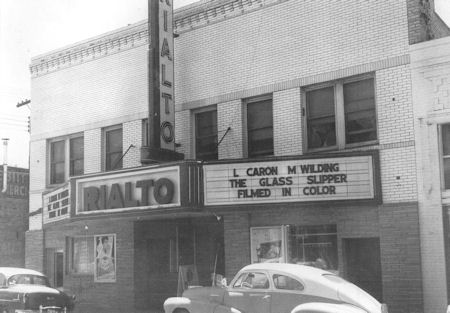
Rialto Theater
To the joy of northern Arizona residents, the Rialto Theater opened in Winslow in July of 1927. Built by Rickards and Nace Amusements, the new theater had fine opera chairs and an air conditioning system. It was said to be one of the finest in the state of Arizona. At first there were only silent movies, but in 1929 a $20,000 sound system was installed and the “talkies” arrived. The first movie with full sound to play in Winslow was Broadway Melody. This photo shows the theater in the 1950’s, after the marquee lights had been removed from the canopy.
Photo courtesy of the Old Trails Museum/Winslow Historical Society, www.OldTrailsMuseum.org.
photo id: 584

Legislator William Parr
Standing on the corner of Fourth Street and Warren Avenue, territorial legislator William Parr visits with friends. Mr. Parr was one of Winslow’s better known pioneers, and built many of the first houses here. He doubled as both a judge and a mortician. His wife, Frona, was the first woman in Winslow to sell insurance.
Photo courtesy of the Old Trails Museum/Winslow Historical Society, www.OldTrailsMuseum.org.
photo id: 592

Shue Bow Woo
Shue Bow Woo operated his meat market and grocery store in the building north of the Old Trails Museum in the 200 block of Kinsley Avenue. Shue and his wife, Susie, arrived in Winslow from China in 1932. They remained in business for 43 years. This industrious couple raised five children living in an apartment above their store. All five graduated from Winslow High School and went on to complete their college educations. Their careers led them to become a legal secretary, a teacher, a postal carrier, a pharmacist and an attorney.
Photo courtesy of the Old Trails Museum/Winslow Historical Society, www.OldTrailsMuseum.org.
photo id: 585

Charles Daze
Charles Daze, an early settler, being driven in his Ford. He started Daze Transfer, Feed and Livery, located in the first block of Kinsley, west side. His office was at 110 Kinsley. Mr. Daze was a Canadian immigrant and resident of Winslow, A. T., when he received his citizenship on May 7, 1895.
Photo courtesy of the Old Trails Museum/Winslow Historical Society, www.OldTrailsMuseum.org.
photo id: 574

Ben Williams
Ben Williams (in hat), took his children for a hired buggy ride in Winslow Park, which is believed to be in the vicinity of what is now Vargas Park. Ben was part of the Williams trading post family, and co-owned a mercantile in early Winslow with his brother, Johnny.
Photo courtesy of the Old Trails Museum/Winslow Historical Society, www.OldTrailsMuseum.org.
photo id: 575

Ben and Nancy Harris
Ben and Nancy Harris at West End Camp, West Second Street.
Photo courtesy of the Old Trails Museum/Winslow Historical Society, www.OldTrailsMuseum.org.
photo id: 577

Getting Stuck
Left to right: David Figg, Gus Hanson, Joseph LeChance and Bill Kelly looked a little worse for the wear after their car was pulled from a flooded wash. Getting stuck while driving was not uncommon. They were stranded for four days while enroute to the Hopi Snake Dance.
Photo courtesy of the Old Trails Museum/Winslow Historical Society, www.OldTrailsMuseum.org.
photo id: 576

Auto Extraction
A well-known character around Winslow for many years was Benjamin Franklin Ketchum. Known as Frank, he was often called upon to extract automobiles from the Little Colorado River. While serving as town Marshal in the early 1900’s, Ketchum was involved in a notorious shooting which prompted his reputation as “lawman Ketchum, who sure can catch ’em”.
Photo courtesy of the Old Trails Museum/Winslow Historical Society, www.OldTrailsMuseum.org.
photo id: 594

Liberty Bond Parade
The patriotism of Winslow citizens was clearly evident on April 16, 1918, when a Liberty Bond parade was staged to raise money for World War I. The effort involved nearly the entire population and netted over $21,000 worth of war bond sales. The old Methodist church can be seen in the background here, and Babbit Mercantile employees were standing in the intersection of Berry and Third Street.
Photo courtesy of the Old Trails Museum/Winslow Historical Society, www.OldTrailsMuseum.org.
photo id: 595

The Awakening of Spring
The cantata “The Awakening of Spring” was presented on May 21, 1931 in Winslow. Four hundred children from Washington School made up the cast, each dressed in brightly colored handmade crepe paper costumes.
The children were costumed to represent the winter wind, snow, rain, flowers, butterflies, and fairies. In this photo are children who portrayed the winter wind. According to the Winslow Mail newspaper, the auditorium held a standing room only crowd when this delightful play was presented many years ago.
Photo courtesy of the Old Trails Museum/Winslow Historical Society, www.OldTrailsMuseum.org.
photo id: 591

The Awakening of Spring
Costumed children posing before the cantana entitled “The Awakening of Spring” in 1931. This elaborate musical production consisted of 400 children dressed in handmade crepe paper costumes. Different groups were costumed to represent fairies, flowers, butterflies, winter wind, rain, and snow. They danced and sang with the goal of awakening Lady Spring, which they accomplished in the grand finale. The play was held for a packed audience in the brand new Washington School auditorium.
Photo courtesy of the Old Trails Museum/Winslow Historical Society, www.OldTrailsMuseum.org.
photo id: 582

The Awakening of Spring
The cantata “The Awakening of Spring” was presented on May 21, 1931 in Winslow. Four hundred children from Washington School made up the cast, each dressed in brightly colored handmade crepe paper costumes. The children were costumed to represent snow, the winter wind, rain, flowers, butterflies, and fairies.
This photo shows the butterflies, who were portrayed by Mildred Sharar, Joysa O’Hara, Patsy Sughrue, Jean Mosley and Sally Kaufman. The photo was taken on the front steps at old Washington School, although the actual performance was held in the brand new high school auditorium a few blocks away.
Photo courtesy of the Old Trails Museum/Winslow Historical Society, www.OldTrailsMuseum.org.
photo id: 590

The Maypole Dance
The Maypole Dance was a tradition for generations in most American elementary schools. Besides dancing around the pole to signal the arrival of spring, children also created May baskets which were made by hand and filled with treats to be left on the front porch of a friend.
The young girls pictured here wore crepe paper bonnets and Bo-Peep dresses when they performed at Washington School in 1931.
Photo courtesy of the Old Trails Museum/Winslow Historical Society, www.OldTrailsMuseum.org.
photo id: 596
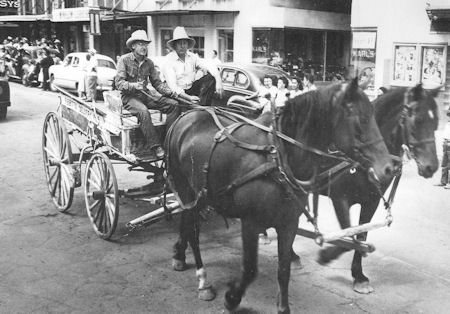
1949 Christmas Parade
Winslow has always loved parades and has had many of them throughout our history. Here in the 1949 Christmas Parade are Albert Young (left) and George Kappes riding in a wagon originally used to deliver groceries for Babbitts in the early 1900’s. In the background are Winslow Drug, Central Drug, Winslow Curio Store, City Bakery, Karl’s Shoes, and a movie marquee for the Chief Theater.
Photo courtesy of the Old Trails Museum/Winslow Historical Society, www.OldTrailsMuseum.org.
photo id: 601

International Travel and Vacation Show
This group attended the International Travel and Vacation Show in New York City in 1948.
Photo courtesy of the Old Trails Museum/Winslow Historical Society, www.OldTrailsMuseum.org.
photo id: 589

A Tom Thumb Wedding
This wedding group was taking part in a popular fad of the 1920’s: a so-called Tom Thumb wedding. All across the country, tiny children were dressed up like adults and entertained audiences in carefully rehearsed mock weddings. These five-year olds were in Winslow kindergarten when they acted out their roles in 1928. On the steps of St. Joseph’s Church (built in 1921), the bride pictured here is Peggy Lee White and the groom is Richard Kleindienst.
Photo courtesy of the Old Trails Museum/Winslow Historical Society, www.OldTrailsMuseum.org.
photo id: 597

Indian Day, 1955
For “Indian Day,” over 2,000 children were given toys by Santa Claus. Held at the west end of La Posada in December 1955, the event was considered a huge success, with hot dogs and pop being served by the Winslow Women’s Club. Close to 4,000 Navajo and Hopi Indians were guests. The fifty horse-drawn wagons were awarded prizes provided by local merchants.The three Navajo women pictured here are Eunice Singer, Hope Thomas, and Maize Thomas.
Photo courtesy of the Old Trails Museum/Winslow Historical Society, www.OldTrailsMuseum.org.
photo id: 602

Restoration of Elk Herd
By 1898, the last Merriam elk in Arizona had been killed. In 1912, the Elks Clubs of Arizona decided to raise funds to begin a project to re-establish the herds. Winslow’s Elk Lodge #536 agreed to take the responsibility of working out the details. Eighty-six elk were corralled near Gardiner, Montana, and shipped by train to Winslow. They arrived on Feb. 16, 1913, and rested in the Santa Fe Stockyards for a couple of weeks. They were then loaded onto several wagons and hauled through a snowstorm to corrals 45 miles south of Winslow. After a month they were released into the wild, thus restoring the species to Arizona. In total the project cost $2,125.
Photo courtesy of the Old Trails Museum/Winslow Historical Society, www.OldTrailsMuseum.org.
photo id: 725

Welcome to Winslow
For several decades Winslow has welcomed highway travelers to our city with this colorful sign which still stands at the west end of town. It was built at a cost of $2100, with expenses shared by the Chamber of Commerce, the City, and a number of local businesses. A giant “good morning” kachina dominated the south end of the sign, painted on a background of the Painted Desert and mesas typical of the countryside around Winslow. Native stone including petrified wood was used in the construction.
Overall the sign measures 41 feet long and 17 feet high. It was dedicated in a special ceremony conducted by Mayor Floyd Whipple in October, 1951. Today one end is deteriorated and the sign is more simple.
Photo courtesy of the Old Trails Museum/Winslow Historical Society, www.OldTrailsMuseum.org.
photo id: 726

Winslow News Store
In 1908 Theodore Niethammer (center) arrived to work for the railroad. He soon decided to open the Winslow News Store, which sold reading materials, Edison phonographs, and souvenirs. Located just east of what is now the Reminder Building on Second St., the store eventually became the front part of a movie theater. Patrons entered the store, bought treats and movie tickets, then entered the theater through a door at the rear. Mr. Niethammer was an involved and caring citizen who served on the Board of Trustees for the local schools. He was instrumental in guiding the progress of the building of two new elementary schools in 1917, South Side School and Froebel (later renamed Washington) School. He moved his family to California in 1920.
Photo courtesy of the Old Trails Museum/Winslow Historical Society, www.OldTrailsMuseum.org.
photo id: 727

First Freight Office
This is a very early and rare photo of the first freight office and water tower in Winslow. The tall man in the center had just purchased a large Hopi pot from the woman who made it. He is Dr. Oscar Brown, who arrived in Winslow in 1898 as the Division Surgeon for the Santa Fe Railroad. Not only was he a medical doctor, he also became certified as a druggist and an optometrist. He took care of people from all over northern Arizona, including a Navajo leader whom he saved from a rattlesnake bite. At a height of 6 foot 7 inches, Dr. Brown was a man that stood out. The highly respected doctor retired in 1931 after thirty three years in Winslow. He was 73 years old then, but after moving to California he still practiced medicine until his death in 1949 at age 91.
Photo courtesy of the Old Trails Museum/Winslow Historical Society, www.OldTrailsMuseum.org.
photo id: 728

William E. Beck
William E. Beck came to Winslow as a young man and stayed to establish a men’s clothing store on the corner of Kinsley Ave. and First St. He is seen here as a bachelor in his room at a local boarding house in 1910, surrounded by his treasures. Navajo blankets and sashes, beaded moccasins, Hopi baskets and hunting trophies adorned the room alongside contemporary items such as calendars, post cards, and family portraits. Mr. Beck married schoolteacher Mary Lee in 1911. They built a home on the corner of Aspinwall and Berry St. and had two children here before moving to Show Low, Arizona, Their daughter was the late Louise Beck Lancaster, a longtime resident of Winslow who taught fourth grade at Lincoln School.
Photo courtesy of the Old Trails Museum/Winslow Historical Society, www.OldTrailsMuseum.org.
photo id: 729

Olds Brothers Lumber Co.
Olds Brothers Lumber Company stood for many years on the northeast corner of Third Street and Kinsley Avenue. This photo of the interior of their store was taken in the early 1930’s. Besides paint, lumber, and home building supplies, the store sold Kelvinator refrigerators and Maytag washing machines. Store employees seen here are Roy Sumpter, Mary Kobel, and owner Hugh L. Boyd. The store burned in a spectacular pre-dawn fire on June 17, 1954, sending paint cans exploding into the sky like fireworks. Employee Roy Sumpter once tried to tunnel into the basement of the First National Bank of Winslow, where the Old Trails Museum is now. He was so worn out from digging that he crawled out to the sidewalk to rest and was picked up by two night patrol policemen.
Photo courtesy of the Old Trails Museum/Winslow Historical Society, www.OldTrailsMuseum.org.
photo id: 730

The Fourth of July
The Fourth of July always bring out Winslow’s powerful feelings of patriotism. Records show that during both World War I and II, more war bonds were sold in Winslow than any other rural town in Arizona. Old newspaper articles tell the story of hundreds of occasions when Winslow citizens gathered to honor the flag and celebrate our freedom. This photograph dates to the 1930’s when a parade was in progress on Second Street near Babbitt’s Mercantile. In the background is the world famous Santa Fe Indian Band, which thrilled crowds everywhere they played. The Babbitt building is still standing and will possibly be restored in the near future.
Photo courtesy of the Old Trails Museum/Winslow Historical Society, www.OldTrailsMuseum.org.
photo id: 731

Hopi Snake Dance Jingle
In 1951 the Winslow Chamber of Commerce co-sponsored a contest in cooperation with the Arizona Republic newspaper. The contest consisted of adding a fourth line to a jingle about the Hopi Snake Dance. The first three lines of the jingle were:
The Hopis hope, as Hopis do
That rain’ll fall when the dance is through
But wriggling rattlers always know
Whomever came up with the best line to finish the jingle would win the contest. The prize was an all-expense paid trip to Winslow and a visit to the Hopi village of Mishongnovi to view the Snake Dance. The contest was won by a Safford couple, who arrived in Winslow on August 18, 1951. They were thrilled with their royal treatment, which included a stop at this Navajo hogan. On the far right is Chief Joe Secakuku, a Hopi priest. The Navajo family is unidentified. The winning line for the jingle was: “they’ll soon be wet and free to go.”
Photo courtesy of the Old Trails Museum/Winslow Historical Society, www.OldTrailsMuseum.org.
photo id: 732

Beard Growing Contest
September is traditionally the month for rodeos in Winslow. In 1948 the sponsoring Jaycees decided to add a little fun to the event by having a beard growing contest. The second man from the left was judged the winner but was later disqualified when it was learned he had trimmed his beard to make it look longer. So T. W. Gill, second from right, was declared winner. One of his prizes was a year of free barber service at a local barbershop. His other prize was a bottle of whiskey which he promptly consumed. The rodeo clowns put T. W. Gill into a rubber donut in the middle of the bull riding event, and though the bulls were kicking and snorting all around him, he emerged without a scratch. To the far right is the late Jack Pugh.
Photo courtesy of the Old Trails Museum/Winslow Historical Society, www.OldTrailsMuseum.org.
photo id: 733

Winslow High School
Winslow was in the midst of a building boom in 1929-1930. Near the railroad tracks on Second Street, the new Harvey House (La Posada) was under construction. A few blocks to the north on Apache Street, the new high school was being built to accommodate the rapidly growing town. Located on the outer fringes of town, there were few houses in the area then. The new school was dedicated on August 30, 1929, and is still in use.
One cannot begin to name the many scholars, good citizens, and productive members of society to come out of Winslow High School. A few who stand out as exceptional achievers are stage actress Leorena Shipley, U.S. Ambassador to Ghana William Mahoney, U.S. Attorney General Richard Kleindienst, Congressional Medal of Honor recipient Jay Vargas, Ninth Circuit Court of Appeals Judge Michael Hawkins, and nationally known sculptor Jerry Peart. During the 1920’s, Grady Gammage was principal of Winslow High School.
Photo courtesy of the Old Trails Museum/Winslow Historical Society, www.OldTrailsMuseum.org.
photo id: 734
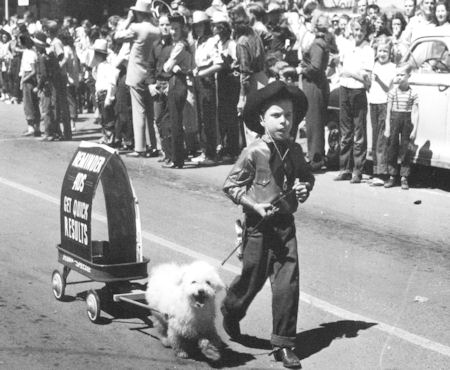
Mister B’s Dog
Anyone living in Winslow the past half of the century is familiar with The Reminder, the popular advertising business owned and operated since 1948 by the Benham family. This photo was taken at a long-ago Christmas Parade in downtown Winslow. The little boy is unidentified, but the little dog “Patrick” was very well known around town as the beloved pet of Mr. L.E. Benham, “Mister B”. Patrick rode everywhere with Mr. B, barking non-stop out the car window while driving the streets. Mr. B liked to walk around to his favorite establishments each day, taking Patrick along with him At each stop along the way, a small bowl of Coca Cola was placed on the floor for Patrick’s enjoyment, because everyone knew it was his favorite drink.
Photo courtesy of the Old Trails Museum/Winslow Historical Society, www.OldTrailsMuseum.org.
photo id: 735

La Posada Hotel
This is the main dining room at the La Posada Hotel on New Year’s Eve, 1953. The famous Harvey House had advertised its party throughout northern Arizona and people came over from Holbrook, Flagstaff, and Show Low to help ring in the new year. A dance was held in the ballroom and the sounds of the Big Bands drifted throughout the building as folks celebrated in style.
In those days, La Posada had the finest kitchen facilities in this part of the state. A large bakery supplied pastries and the famous pies which were Harvey House favorites for decades. Chefs and bakers were recruited from throughout the southwest, and each was encouraged to develop special dishes and recipes associated with their kitchen. One of the best known specialties at La Posada was blueberry muffins.
Photo courtesy of the Old Trails Museum/Winslow Historical Society, www.OldTrailsMuseum.org.
photo id: 736

Winslow Police Car
Photo courtesy of the Old Trails Museum/Winslow Historical Society, www.OldTrailsMuseum.org.
photo id: 737

Kaibito Trading Post
Kaibito Trading Post is on the left. On the right is Day School & Teachers Quarters.
Photo courtesy of the Old Trails Museum/Winslow Historical Society, www.OldTrailsMuseum.org.
photo id: 738
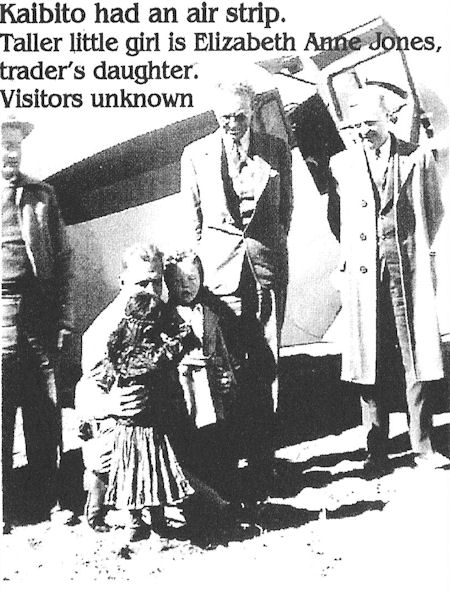
Kaibito Trading Post
Kaibito Trading Post had an air strip. The taller little girl is Elizabeth, trader’s daughter. The visitors are unknown.
Photo courtesy of the Old Trails Museum/Winslow Historical Society, www.OldTrailsMuseum.org.
photo id: 739
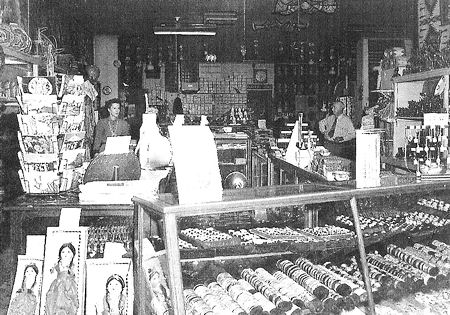
Bruchman’s Curio Store
Bruchman’s Curio Store was located on 113 W. Second Street.
Photo courtesy of the Old Trails Museum/Winslow Historical Society, www.OldTrailsMuseum.org.
photo id: 740

Bruchman’s Curio Store
Bruchman’s Curio Store in the 1920s.
Photo courtesy of the Old Trails Museum/Winslow Historical Society, www.OldTrailsMuseum.org.
photo id: 741

Jonathan Williams and family
In 1882 Jonathan Williams, with the help of his sons William and Ben, built the first registered trading post in Blue Canyon. The isolated area near Hopi country and the Utah border was frequently traveled by those on the lam. Mr. Williams sold the post about ten years later, and located his family in Winslow. Shortly afterward, he departed to search for gold in Mexico, where he died. His wife, Annie, ran a rooming and boarding house for a time on Williamson Street. She died in 1911, and was buried in Winslow.
William was involved with area trading posts for over 30 years. He and his wife, Gertie, had four children. All of them attended Winslow schools. Ben and Johnny worked at other trading posts, and ran a mercantile in Winslow also.
Mary Williams wed Ed Clark and had several children, one of whom was John Clark. He became a local attorney and judge, and later donated to the Museum a large pottery and implement collection his mother excavated in the early 1900’s. Lillian was born at the trading post in 1886, later married, and bore four children in Winslow. She and her family relocated to California.
Photo courtesy of the Old Trails Museum/Winslow Historical Society, www.OldTrailsMuseum.org.
photo id: 742

Cedar Springs Trading Post
In 1919, trader Charles Hubbell, brother to J.L Hubbell, was murdered and his place looted. The father of the killers took the plunder to the Bailey Brothers Trading Post at Cedar Springs to be turned in to the authorities. They were captured and arrested. Wallace testified in court, and Red Lake Trading Post’s W.F. Williams, who was first to arrive at the crime scene, acted as interpreter at the trial. The killers were convicted and served time in prison.
Photo courtesy of the Old Trails Museum/Winslow Historical Society, www.OldTrailsMuseum.org.
photo id: 743
Photo courtesy of the Old Trails Museum/Winslow Historical Society, www.OldTrailsMuseum.org.
photo id: 742

Cedar Springs Trading Post
Arthur and Jennie McLaws Bailey bought the Cedar Springs Trading Post in 1916. Dorothy at age two, circa 1918, was the first of the couple’s five children. She grew up to become a Harvey Girl and Indian Trader.
Photo courtesy of the Old Trails Museum/Winslow Historical Society, www.OldTrailsMuseum.org.
photo id: 744

Cedar Springs Trading Post
Wallace Bailey, partner to Arthur Bailey and his trading post, outside the Cedar Springs Post Office, circa 1920.
Photo courtesy of the Old Trails Museum/Winslow Historical Society, www.OldTrailsMuseum.org.
photo id: 745

Leupp Trading Post
After Cameron Trading Post, Stanton and Ida Borum purchased Leupp Trading Post.
Photo courtesy of the Old Trails Museum/Winslow Historical Society, www.OldTrailsMuseum.org.
photo id: 746

Cameron Trading Post
Stanton and Ida Mae Borum in 1925 when they ran Cameron Trading Post for the Richardsons.
Photo courtesy of the Old Trails Museum/Winslow Historical Society, www.OldTrailsMuseum.org.
photo id: 747

Red Lake Trading Post
The 45 mile journey from Winslow to Red Lake Trading Post took 12 hours by wagon, but only three hours by automobile.
Photo courtesy of the Old Trails Museum/Winslow Historical Society, www.OldTrailsMuseum.org.
photo id: 748
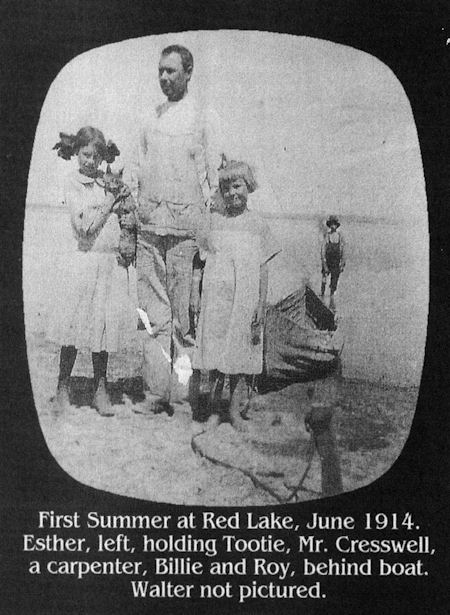
Red Lake Trading Post
First Summer at Red Lake, June 1914. Esther, left, holding Tootle, Mr. Cresswell, a carpenter, Billie and Roy, behind boat.
Photo courtesy of the Old Trails Museum/Winslow Historical Society, www.OldTrailsMuseum.org.
photo id: 749
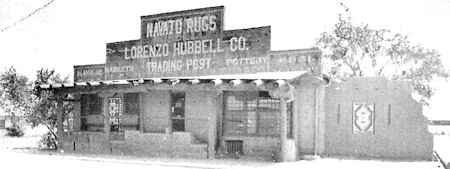
Hubbell Trading Post
Hubbell Trading Post, located at 523 W. 2nd Street, in the mid 1940s.
Photo courtesy of the Old Trails Museum/Winslow Historical Society, www.OldTrailsMuseum.org.
photo id: 750

Hubbell Trading Post
Hubbell Trading Post in the 1950s.
Photo courtesy of the Old Trails Museum/Winslow Historical Society, www.OldTrailsMuseum.org.
photo id: 751

Phil Bruchman Trading Company
Friends and family were an integral part of post life. Roseline Taylor, Viola Barton and Carrie Nez used to come to the Phil Bruchman Trading Company once a month to shop and visit. This photo is from 1995.
Photo courtesy of the Old Trails Museum/Winslow Historical Society, www.OldTrailsMuseum.org.
photo id: 752
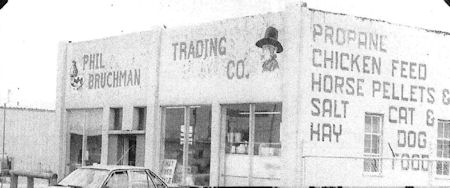
Phil Bruchman Trading Company
Phil Bruchman Trading Company, 1409 E. Second Street, Winslow.
Photo courtesy of the Old Trails Museum/Winslow Historical Society, www.OldTrailsMuseum.org.
photo id: 753
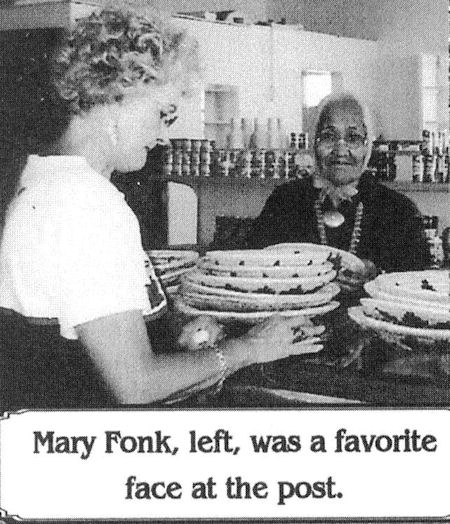
Phil Bruchman Trading Company
Mary Fonk, pictured on the left, was a popular person at Phil Bruchman Trading Company.
Photo courtesy of the Old Trails Museum/Winslow Historical Society, www.OldTrailsMuseum.org.
photo id: 754

Indian Wells Trading Post
Indian Wells Trading Post, circa 1916.
Photo courtesy of the Old Trails Museum/Winslow Historical Society, www.OldTrailsMuseum.org.
photo id: 755
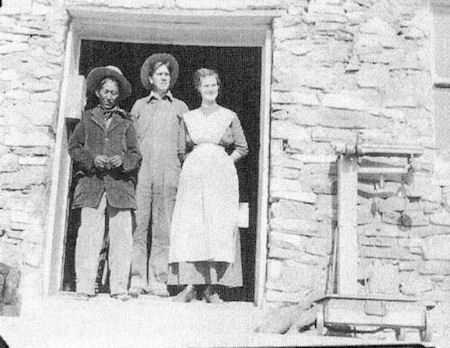
Indian Wells Trading Post
Adil Tone, Arthur Bailey and Miss Sweeney in the door of Indian Wells Trading Post. On the right is the scale used to weigh wool.
Photo courtesy of the Old Trails Museum/Winslow Historical Society, www.OldTrailsMuseum.org.
photo id: 756

Indian Wells Trading Post
Mrs. E. J. Marty, wife of a partner in Indian Wells Trading Post. After graduation in Joseph City, Jennie McLaws moved there to be a seamstress for the family. There she met Arthur Bailey who was working as a cowboy. They wed in 1915.
Photo courtesy of the Old Trails Museum/Winslow Historical Society, www.OldTrailsMuseum.org.
photo id: 757

Indian Wells Trading Post
Two employees, Arthur Bailey and Miss Sweeney, entertaining themselves one afternoon by roping each other.
Photo courtesy of the Old Trails Museum/Winslow Historical Society, www.OldTrailsMuseum.org.
photo id: 758

Hunt’s Feed and Supply
Dorothy Hunt at the Bright Angel Lodge in 1959. Many remember Dorothy as a Harvey Girl, but few know that her grandparents were among the first settlers of northern Arizona Territory. She was born in 1916, the same year her father bought Cedar Springs Trading Post.
Photo courtesy of the Old Trails Museum/Winslow Historical Society, www.OldTrailsMuseum.org.
photo id: 759

Hunt’s Feed and Supply
Dorothy Hunt at the Bright Angel Lodge in 1959. Many remember Dorothy as a Harvey Girl, but few know that her grandparents were among the first settlers of northern Arizona Territory. She was born in 1916, the same year her father bought Cedar Springs Trading Post.
Photo courtesy of the Old Trails Museum/Winslow Historical Society, www.OldTrailsMuseum.org.
photo id: 759

Hunts Feed and Supply
Dorothy Hunt became a trader herself after she and her husband started the feed store. They took in so much pawn that she made several selling trips a year for many years as far away as Oklahoma, wearing out three cars in the process.
Photo courtesy of the Old Trails Museum/Winslow Historical Society, www.OldTrailsMuseum.org.
photo id: 761
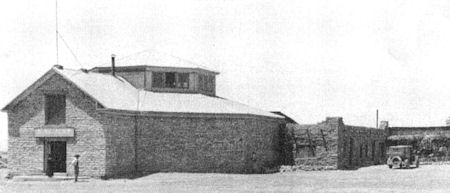
Tuba Trading Post
Jot and Marjorie Stiles ran Tuba Trading Post for the Babbitts. Though an isolated spot, the Stiles’ lifestyle was active and filled with people, often Hollywood types making movies in the area. Marjorie was even asked to be in the cinema. She loved to entertain guests.
Photo courtesy of the Old Trails Museum/Winslow Historical Society, www.OldTrailsMuseum.org.
photo id: 762

Tuba Trading Post
Marjorie Stiles, who helped run the Tuba Trading Post, is third from left against the wall.
Photo courtesy of the Old Trails Museum/Winslow Historical Society, www.OldTrailsMuseum.org.
photo id: 763

Tuba Trading Post
Jot Stiles, operator of Tuba Trading Post. One of his early jobs in the area was riding to the Rim Country on horseback, armed with a rifle, collecting bad debts for a local bank.
Photo courtesy of the Old Trails Museum/Winslow Historical Society, www.OldTrailsMuseum.org.
photo id: 764

Leupp Trading Post
William E. and Lucile McGee, above left, had been in the trading post business since 1923 when they purchased Leupp Trading Post in 1944 from Ida Mae Borum. After they retired in 1968 their son, Elmer, and his wife, Ellen, ran it until 1982. The family living quarters were on the second floor, and had been redone by Mrs. Borum.
Photo courtesy of the Old Trails Museum/Winslow Historical Society, www.OldTrailsMuseum.org.
photo id: 765
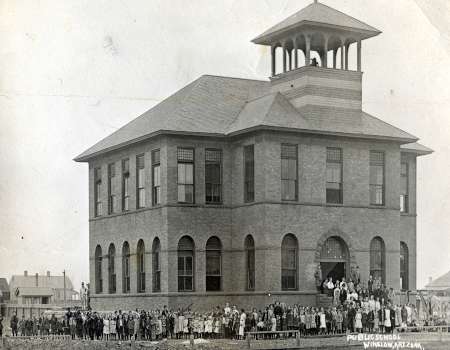
Winslow Grammar School
Shown here is Winslow Grammar, later named Lincoln School, which opened in 1897 on West Oak. The impressive brick building was a source of pride to Winslow residents, due in part to the stained glass windows in the classrooms and the beautiful bell tower that summoned generations of students to class. Lincoln School remained in service until the 1970s, when it was razed along with the original Washington School to make way for the new Washington “Dome” school.
Photo courtesy of the Old Trails Museum/Winslow Historical Society, www.OldTrailsMuseum.org.
photo id: 1096

Major L.M. Shipley, seated at center, during his 1918 tour of duty in France.
Major Shipley worked as the trainmaster for the Santa Fe Railroad. After returning from France he accepted the position as general manager of the Apache Railway, office in Loas Angeles, CA. Some of his mementos from his World War I service were donated to the Old Trails Museum.
Photo courtesy of the Old Trails Museum/Winslow Historical Society, www.OldTrailsMuseum.org.
photo id: 1098

Trading Posts
Traders, usually Anglos, often became the intermediaries between Native peoples and the outside world, providing not only hard goods but services including translation, correspondence, and transportation. Trading posts were the sites of marriages and murders, and they also became destinations for artists, authors, and tourists. Though trading posts have all but disappeared with the coming of improved roads and affordable, this presentation will provide a glimpse into a vanishing time in the Southwest.
photo id: 1203

Hashknife Cowboys of Holbrook
In 1885 the Aztec Cattle Company moved its headquarters to Holbrook. The following year they purchased one million acres from the Atlantic and Pacific Railroad for 50 cents per acre. They were the third largest cattle company in America, stretching 650 miles from New Mexico to South of Flagstaff.
The cattle company bought the Hashknife brand and moved 33,000 head of livestock to the ranch. The nickname Hashknife Outfit was given to the company because their brand looked like the hash knives the cooks used.
Holbrook welcomed the business until they realized what came with it: Hashknife cowboys quickly became known as the “thievinist, fightinest bunch of cowboys” in the U.S. They brought in men from every walk of life to do the ranching, including criminals and outlaws. Cattle rustling, train robberies, and hotheaded gun fights were daily activities. Holbrook was a town of 250 residents and had 26 murders from gun fights in one year. The rustlers would even steal Hashknife cattle and sell it. The local ranchers resented the cattle stripping the range and the cow hands stealing their livestock.
Photo used with permission of the Navajo County Historical Society Museum
photo id: 120
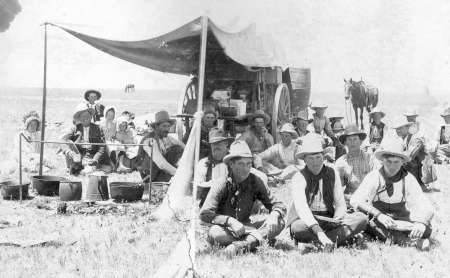
Chuck Wagon, 1903
The Chuck Wagon was an important part of the cattle drives and wrangling in the Old West. A good cook on the range was highly valued by the hands. A hot meal after a hard day’s work was appreciated.
Winslow was an important cattle transport station, since the Santa Fe Railroad Divisional Headquarters was positioned there. In 1885 drought and overstocking nearly devastated the ranching industry.
Later, in the late 1890s, thousands of cattle were lost during a severe blizzard. The Aztec Land and Cattle Company was not able to recover from the loss and sold to the Babbit brothers in 1901.
photo id: 443

Cowboys at Courthouse
Before an iron picket fence was added around the Navajo County Courthouse in the early 1920s, cowboys, U.S. Calvary camps, and teepees could be seen around it. The County courthouse was an imposing structure that sat alone for a number of years.
The Navajo County Courthouse was built in 1898. The courthouse itself cost $12,000 to build. The jail inside was specially built in St. Louis and brought by train for a cost of $3,000. The courthouse was in operation until 1976 when a new county governmental center was established several miles south of Holbrook. In 1981 the Navajo County Historical Society took over the old courthouse building and opened a museum there.
Photo used with permission of the Navajo County Historical Society Museum.
photo id: 531

Hashknife Outfit Winslow
photo id: 447

Family Dinner on the Trail
Ed Hennessy and his family stopped for the evening as they traveled to Holbrook from the east. Even though they were on the road, they would have a hot dinner before turning in. Hennessy joined up with the Hashknife Outfit that ran thousands of head of cattle along the railroad line across northern Arizona in the late 1880s. When the cattle business closed up, Hennessy was among many of the cowboys who stayed on in Holbrook.
Photo used with permission of the Navajo County Historical Society Museum.
photo id: 118

Marley
photo id: 446

Cecil Creswell: Cattle Rustler
Olive Dove Van Zoast was trained and hired by Fred Harvey Company in 1918. Her first job with them was at the Harvey House in Winslow. When and why she changed her name to Cecil is unknown.
While working at the Harvey House in Winslow she met George Creswell, a Bureau of Indian Affairs livestock inspector. After George died Cecil Creswell moved to their 160 acre homestead south of Winslow by Clear Creek. Being a strong woman, she built her home, corrals, and fencing by herself. She stocked her ranch with rustled cattle from surrounding families. Her neighbors knew what she was doing but were unable to stop her. Even the sheriff of Winslow was sympathetic to her rough survival and would take meals to Cecil to keep her from starving. In 1954 the law finally caught up with her rustling, but before they could arrest her, she chose to end her life.
photo id: 483

Smith-Haight 1923
photo id: 445

Hashknife Cowboys
Pictured are two Hashknife cowboys in Holbrook. Cowboys rode the range for the Aztec Land and Cattle Company, which was better known as the Hashknife Outfit. The cowpunchers were wild and stirred up trouble, so Sheriff Commodore Perry Owens was brought to town to tame the West. Although the sheriff and his deputy, Frank Wattron, were able to calm the towns and rid them of most outlaw gangs, the Aztec Company was still being plagued by rustlers. In 1898, out of desperation, Bill Mossman was hired to run the ranch for the Aztec Company. He started by firing 52 of 84 Hashknife Cowboys. Determined to clean up the problems he sent 11 more to jail for rustling. His war on rustlers helped Holbrook finally make the town “fit for women and children.”
Photo used with permission of the Navajo County Historical Society Museum.
photo id: 121

Grandstand at the County Fairgrounds
The grandstand at the county fairgrounds was packed for events, and the young ladies were dressed to the nines during the 1929 flapper era.
Photo used with permission of the Navajo County Historical Society Museum.
photo id: 139

Sheep Ranch Homestead
photo id: 444

Wool Wagons
Ox teams freighting wool in Holbrook.
Photo used with permission of the Navajo County Historical Society Museum.
photo id: 533

Cattle Branding
Cowboys brand cattle at the Bar T Bar’s Hay Lake Ranch near Happy Jack, circa 1950s.
Photo courtesy of the Old Trails Museum/Winslow Historical Society, www.OldTrailsMuseum.org.
photo id: 1097

Fred Harvey House
Fred Harvey was merely 15 years old when he left England and headed for New York City in 1850. After his arrival he found work in the food service industry. During the Civil War the restaurant business did not fail well, but the railroad was really picking up. Fred made a career change and went to work for the railway. Throughout the next 20 years he was able to travel with his job and see the need for quality food service like he had experienced in New York City.
He met with the railroad and worked out plans to have quality restaurants at various stops and dining cars on the trains. He proved that tourists on the railway deserved and would pay for better service. The Harvey House was born.
photo id: 448

First Harvey House
The first Harvey house in Winslow, completed in 1897, south of the A&P main line. After the La Posada Harvey Hotel opened in 1930 this facility was used for railroad offices. It was torn down in 1964.
photo id: 605
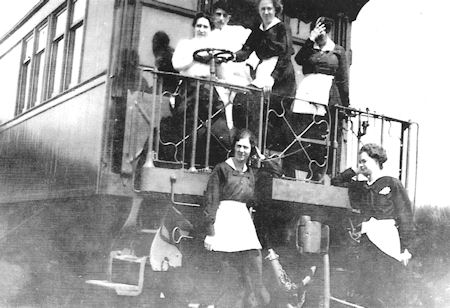
Harvey Girls
One of the earliest photos of Harvey Girls.
photo id: 606

Black and White Uniforms
Standing in front of the old Winslow Harvey House in 1918, these young women wore the distinctive black and white uniforms which identified them as Harvey Girl waitresses. On the left is a Native American woman selling her pottery to hotel guests and train passengers. Third from the right is Juanita Gale Creswell, known locally as “Cecil.” She was the only known Harvey Girl to have become a cattle rustler.
photo id: 598

Harvey Girls Crew
photo id: 450

Harvey Girls
Nine Harvey Girls pose outside Winslow’s first Harvey House in 1918.
photo id: 607

Harvey House Crew
One half of the Harvey House crew as taken in 1917. This is the oldest house staff photo on file. Seated at right are W. V. Belding, Manager, Mrs. Belding, and their son, Walter, Jr. Second row, fourth from left is Helen Quinn, head waitress.
photo id: 608

Verna Northcutt
Verna Northcutt came to Winslow in 1938 at the invitation of Roy Wright, then manager of La Posada, whom she had met in Newton, Kansas. Verna hoped for a secretarial position, but instead worked as a Harvey Girl until her marriage in 1941 to L. D. Welsh.
photo id: 611

Loading Food Boxes
In the service of the famous Fred Harvey Company, these gentlemen were busy loading boxes of food onto a Santa Fe passenger train near the depot. The food had been prepared and boxed in the spacious kitchens in La Posada Harvey House during the heyday of railroad passenger travel. Pictured here are Refugio Guzman, Leroy Garcia, Bennie Rodriguez, Abelino Perea and Tony Perea.
photo id: 600

Harvey House Fire 1914
Fires were tragic but regular occurrences in the early 20th century. This photograph shows men fighting the fire at Winslow’s Harvey House using Santa Fe engine number 2052 as a pumper.
photo id: 451

La Posada, 1930
This northern elevation panoramic of La Posada was taken in 1930 near opening day. Construction costs came in at $1 million, much over the estimated $600,000. The tower to the right of the entrance was for cooling, and helped maintain an even temperature in the public areas of the building.
La Posada, reputed to be the pride of architect Mary J. E. Colter, closed its doors in 1958 as a Harvey Hotel. It was used as railroad offices, then later vacated. The effort of many locals to save it has been validated by its present-day restored grandeur, gardens and restaurant.
photo id: 610

La Posada Hotel Crew
photo id: 453

La Posada Dining Room
The hotel dining room of La Posada, circa 1930.
photo id: 454
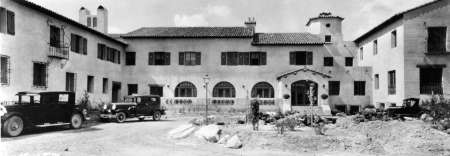
La Posada Hotel Exterior
La Posada was the last Harvey House built in the Southwest. The name La Posada means “The Inn” or “resting place” in Spanish. It was built to resemble a hospitable Spanish hacienda.
photo id: 452

La Posada Staff
A staff picture for La Posada taken in 1930. Omar Dooms, manager, is seated far left, second row.
photo id: 609

La Posada Hotel Staff
photo id: 456
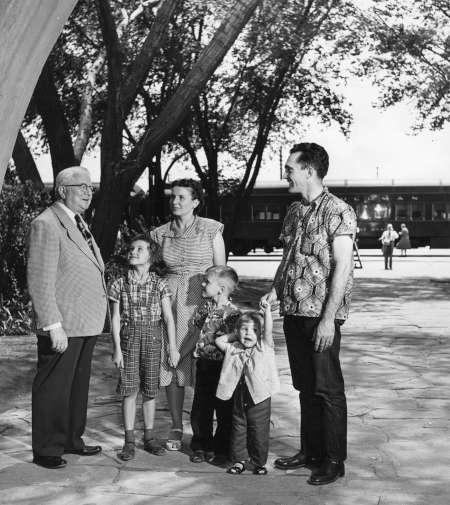
La Posada Hotel Weber
photo id: 457

New Years Party
A New Years Eve party at La Posada in 1950.
photo id: 458

Winter
The La Posada hotel during a winter snowstorm.
photo id: 459

La Posada Aeriel View
An aerial view of La Posada Hotel.
photo id: 460
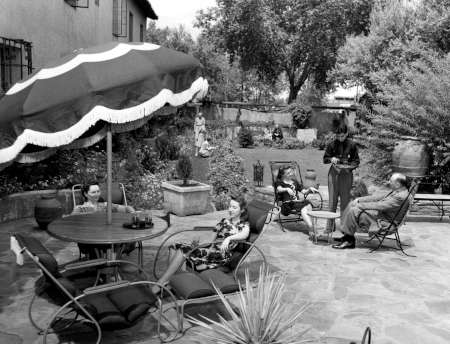
La Posada Gardens
La Posada’s Gardens, circa 1950. La Posada’s most famous guests include presidents Franklin D. Roosevelt and Harry Truman; aviators Amelia Earhart and Charles Lindbergh; and movie stars John Wayne and Will Rogers.
photo id: 455

Harvey Girl “Jean” in front of La Posada Hotel in 1936
Entrepreneur Fred Harvey opened a series of eating houses along the Santa Fe Railway that evolved into America’s first restaurant chain. From 1876 through the 1960s, Harvey and his family introduced exceptional food, service, atmosphere, and value to westward travel, and one of their many innovations was the hiring and training of women to be “Harvey Girls.” Through their fortitude and sense of adventure, the Harvey Girls helped settle the American West by marrying local men, raising children, and getting involved in their adopted communities.

Inspection Station
An inspection station was located just outside of Holbrook on Route 66 to check for any bug infestations of fresh fruit. The above photo was taken after a snow storm. Inspections were conducted because of the concern for diseases the produce may have been carrying. Introducing pests and diseases to a new area can jeopardize the agriculture as well as the health of humans and animals in that area. There are procedures you must follow when transporting vegetables across borders, and violations of those rules carry potentially large fines.
Photo used with permission of the Navajo County Historical Society Museum.
photo id: 69

Holbrook Courthouse 1930
The Navajo County Historic Courthouse is located on Historic Route 66 in downtown Holbrook.
Built in 1898, the courthouse serves as an Arizona Office of Tourism endorsed visitor center and as an area museum. It included a jail in operational times. This jail had never had any escapes.
Photo used with permission of the Navajo County Historical Society Museum.
photo id: 116
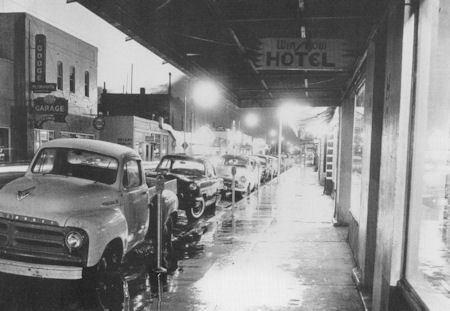
Downtown Winslow
A storm had left the downtown streets glistening back in the mid-1950’s when this photo was taken. It was busy at night in downtown Winslow in earlier years, before the Interstate came along. Patrons visited the Rialto, the Skylark, the drugstore fountains, and cafes named the Grand, the White, and the National. Route 66 travelers looking for a place to spend the night often ate a meal in a cafe, then went upstairs to check into a little hotel located there. This view is looking west from the corner of Second Street and Williamson.
photo id: 588

Campground
A campground along Route 66 in the 1950s.
Photo courtesy of the National Park Service.
photo id: 1040
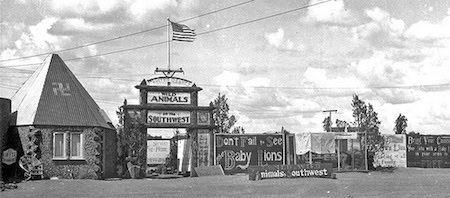
Roadside Attraction
A roadside attraction on Route 66 near Petrified Forest during the 1950s.
Photo courtesy of the National Park Service.
photo id: 1042

View of Second Street/Route 66 in downtown Winslow 1951
You’ve heard a lot about getting your kicks on Route 66 from the famous 1946 song by Bobby and Cynthia Troup, but do you know Winslow’s Route 66 history? Do you remember when the big semis went both East and West on Second Street? Are you old enough to recall Peter Paul’s candy shop, or the popcorn stand? Marshall Hayes’ or Boney Candelaria’s shoe repair shops? Did you buy your moccasins from Bruchman’s, or hang out at the National or Grand Cafés? Do you remember when Jim Irwin went to work for Whitey Larson at the Standard Station?
Winslow’s stretch of Route 66 also accommodated two five-and-dime stores, and Marcher Motors and APS were right on the corner of Second Street and Williamson Avenue. Babbitt’s Department Store, J.C. Penney’s, Buckley’s Bootery, Central and Winslow Drugs, Ralph and Bessie’s BBQ.
Photo courtesy of the Old Trails Museum/Winslow Historical Society, www.OldTrailsMuseum.org.
photo id: 1101
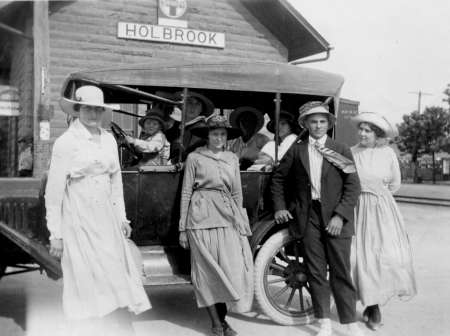
Waiting at train depot in Holbrook
The Atlantic and Pacific Railroad laid tracks through Holbrook in 1881.
The railroad had a major impact on the growth of the area along Route 66. It was responsible for ranching, both cattle and sheep, to move to Holbrook. This station, built in 1892, replaced the earlier station. As traffic grew, additions were made in 1907 and 1912. Santa Fe continued to serve this station with the Grand Canyon until the discontinuance of that train in 1971. This depot was restored in 2006 as a historical landmark, although trains no longer stop here.
Photo used with permission of the Navajo County Historical Society Museum.
photo id: 530

Passenger and Freight Trains
Sometime in the early 1970’s the railroad took a series of photographs in northern Arizona. The location of this photo is atop the Canyon Diablo bridge about twenty five miles west of Winslow. Sitting at the controls in the passenger train on the right are engineer John Bennett and his fireman Boyd Shumway. Alongside them is a freight train, both headed eastbound toward Winslow. The bridge at Canyon Diablo was constructed in 1947 and is a spectacular sight from the edge of the canyon. In the background are the snowcapped San Francisco Peaks.
“The sun setting behind the San Francisco Peaks, so deeply blue against the orange and red of the cloud blankets…
The eastbound freight that used to steam out of Winslow and whistle into top speed at the stockyards, just as I was falling asleep every night on the back porch.”
“Memories of Winslow”, written September 1, 1942 by William Patrick Mahoney, Jr. , in his journal. The 1934 graduate of Winslow High School served as Ambassador to Ghana under President John F. Kennedy.
photo id: 771

Winslow Railroad Workers
A group of Winslow railroad characters hanging out in Gallup waiting for their trains. For many years every railroader had a nickname, bestowed on them by their fellow workers. Some that are memorable are “Ewe” Hodge, “Bowtie” Boggan, “Bishop” Randall, “Saturday Night” Griffith, and “FooFoo” Webb. Engineers are still referred to as “hogheads.”
From left to right in this photo are “Soup” Chambers, Bob Cahill, Oliver Hardy, Rex Haney, and “Moqui” Hasten. The photo was taken in the early 1970s.
photo id: 768
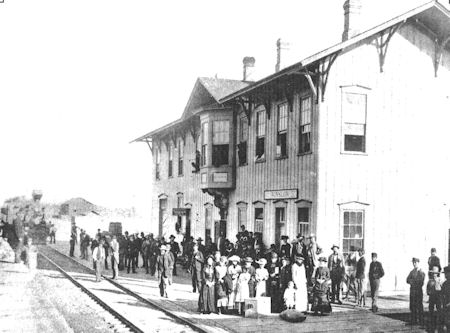
Winslow Railroad Workers
A group of Winslow railroad characters hanging out in Gallup waiting for their trains. For many years every railroader had a nickname, bestowed on them by their fellow workers. Some that are memorable are “Ewe” Hodge, “Bowtie” Boggan, “Bishop” Randall, “Saturday Night” Griffith, and “FooFoo” Webb. Engineers are still referred to as “hogheads.”
From left to right in this photo are “Soup” Chambers, Bob Cahill, Oliver Hardy, Rex Haney, and “Moqui” Hasten. The photo was taken in the early 1970s.
photo id: 768

Reed Hatch
Reed Hatch poses in front of a train.
photo id: 305

Engineer Robert Moore
Robert Moore, left, was a longtime engineer for the Santa Fe. In 1911 he married a Harvey Girl named Minnie, who was working at the El Navajo Harvey House in Gallup. In Winslow the Santa Fe assigned each crew (engineer and fireman) its own engine. Number 1423 was Moore’s, and he called it “Old Huldy.” It was built in 1906 and scrapped in 1928 after years of hard work pulling passenger trains. The engine was a coal burner as were all on the Second District. Moore is seen here with his fireman, Art Dewey.
photo id: 772
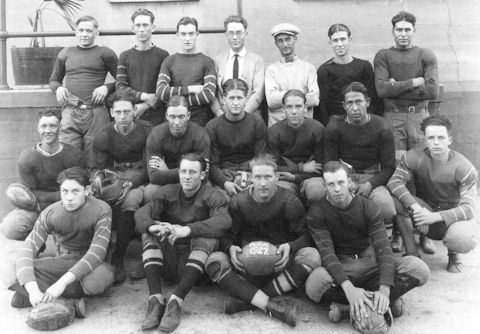
Santa Fe Football
In the early days the young railroaders liked to have a bit of competitive fun by creating rivalries with the other railroad towns. They formed baseball and football teams, calling themselves the Blue Devils, the Cardinals, and the Meteorites. They rode the train to places like Ash Fork and Williams to butt heads with their rivals. This photo is of the Santa Fe apprentice football team in 1927. Ted McBride, Ray Blumlein, Bill Miley and Manuel Sandoval all played on this team.
photo id: 773

Canyon Diablo Bridge
The original railroad bridge spanning Canyon Diablo (Devil’s Canyon) constructed in 1882 near Two Guns, AZ between Flagstaff and Winslow, north of Interstate I-40. The town of Canyon Diablo sprang up while the bridge was being constructed and grew to a population of around 2000 people, but after the bridge was completed, the town soon became a ghost town with hardly a trace remaining.
photo id: 544

Canyon Diablo Bridge 1950
The Canyon Diablo Bridge on the Burlington Northern Santa Fe Railroad was built in 1946 to replace the trestle from 1882, in a remote area located near Two Guns, Arizona, that is difficult to reach by car. The length of the bridge is 544 feet.
This steel arch Canyon Diablo Bridge is listed on the National Register of Historic Places.
photo id: 545

Canyon Diablo Bridge
The men laying railroad track reached the edge of Canyon Diablo in December of 1881 and had to halt work for six months while the first bridge was built. It was the most daunting of the major bridges constructed by the railroad. Using stones native to the site, masons built the footings that would support the eleven iron spans holding the tracks. It took 240 workers to construct the bridge, and the total cost was $250,000. The first train rolled across it in July of 1882 at a speed of four miles per hour. People in the trains didn’t realize they were 225 feet above the canyon floor. The first bridge, shown above, was replaced in 1900 by a second, stronger bridge which served mightily in World War II. It was so critically important to the transport of troops and war materials that it was heavily guarded. A new double track bridge was built in 1947 and is still in use.
Photo used with permission of the Navajo County Historical Society Museum.
photo id: 774

A&T; Locomotive passing through Canyon Diablo
Engineer McCauley passed through Canyon Diablo in an A&T locomotive on July 10, 1888.
The construction of the Atlantic & Pacific Railway, predecessor of the Santa Fe Railway, first reached the Winslow area in late 1881, and within a month had stretched westward an additional twenty-five miles to Canyon Diablo. From the beginning Winslow was a both a division point and crew change location, which resulted in the railroad investing heavily in Winslow’s development and growth. In addition, these important designations guaranteed the need for a substantial local work force to maintain railroad operations.
Photo courtesy of the Old Trails Museum/Winslow Historical Society, www.OldTrailsMuseum.org.
photo id: 1090
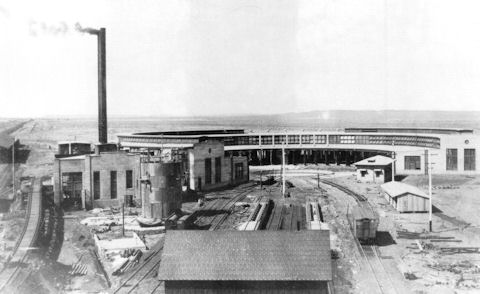
Winslow Roundhouse
This is the third roundhouse erected in Winslow. The first was located slightly east of where La Posada now stands. It burned in a spectacular fire in the spring of 1895, which also destroying nine valuable steam engines. A new roundhouse was rebuilt on the same site, but it needed to be removed from the downtown area. In 1920 this roundhouse was completed out on the west end of town. In this photo, the structure was still under construction and didn’t have a turntable yet.
photo id: 775

Snowstorm of 1967
In early December of 1967, the local weatherman predicted a storm producing a couple inches of snow. But the Navajo and Hopi people were saying “the big one is coming,” and they were right. It began to snow on December 13, and fifty inches of it had fallen when the storm finally ended. This photo shows the depot at La Posada during that time.
photo id: 776

Engine 2052
photo id: 539

Engine
photo id: 541
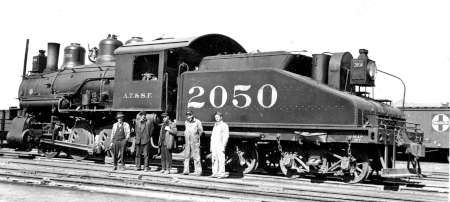
Locomotive
photo id: 542

Snow of 1967
These Winslow railroaders struggled along with everyone else in northern Arizona in December of 1967, when about three and a half feet of snow nearly buried us. Seen here are brakeman A.J. Whitley, brakeman J.L. LaFever, Conductor W.S. Hodge, fireman J.L. Straub, and engineer T.W. Gill.
photo id: 766

Santa Fe’s Harvey House
The Santa Fe decided to build the last Harvey House in their system here in Winslow. It would replace the old 1897 structure south of the tracks, and it was destined to be the golden jewel of the chain of resort hotels. It was nearly finished when this photo was taken in March of 1930. It was named La Posada, “the resting place” and became the favorite building of its architect, Mary E.J. Colter. Many years earlier a roundhouse stood on this spot, but it was removed in 1921.
photo id: 767

Clear Creek Pumphouse
As the rails inched their way across Arizona’s terrain in the 1880s, finding adequate sources of water for the steam engines was critical. Wells were drilled by the company, and pumphouses were built near canyons and rivers. The first water source for the Winslow railyards was a pumphouse at the edge of the Little Colorado river. In 1898 the Santa Fe constructed a new pumping facility at nearby Clear Creek, as seen in this photo. The water was pumped from the deep canyon and stored in a reservoir, then pumped five miles across the desert to the roundhouse. This technology aided local ranchers by allowing them to install similar pumps to extract water for their livestock.
photo id: 769

Railroad Ladies Auxiliary
The wives of the railroaders faced some tough times in early day Winslow. Before the first Chinese laundry came in, they had to deal with trying to keep their men clean. Scrubbing overalls that had been worn on an engine or in the roundhouse was brutal work. And just about the time they hung the wash out to dry, along came a dust storm. They missed their families back home, and they longed for trees and flowers in their red dirt yards. So they formed networks and societies such as the Railroad Ladies Auxiliary, shown here with their new charter on June 14, 1897. They organized grand balls attended by people from throughout the Territory, among other activities.
photo id: 770

Early Railroad Shop in Winslow
The railroad played a large part in the creation of towns in northeastern Arizona.
Once known as Sunset Crossing, Winslow was nothing more than a river crossing in the early days. That changed when the train stopped there to refuel and change crews. Winslow was most likely named after Edward Winslow, president of the San Francisco and St. Louis Rail Road.
photo id: 546

Read Room
The Harvey House, Reading Room, and Hospital, built in 1908.
photo id: 548

Penzance
photo id: 549

Office Crew
photo id: 550

1929 Crew
Winslow’s early railroad facilities included a machine shop, engine house and blacksmith shops, followed soon by a depot, freight house, eating house and stockyards. Private development along Railroad Avenue (now First Street) also blossomed as entrepreneurs Fred Demarest, J. H. Breed and others built hotels, restaurants, saloons and mercantile stores to supply the needs of the new community. By February 14, 1912, Winslow was the most vibrant town in the northern portion of the new state of Arizona.
photo id: 551

Ice House for Refrigerated Freight Cars
Refrigerated freight cars were developed in 1886, opening up a new market for fresh produce grown on the west coast. Perishable products could be shipped throughout the country without spoilage, even in summer. Ice had to be manufactured in large quantities and replenished at various points along the way. Winslow both manufactured ice and loaded it into the refrigerator cars. This enormous ice plant in Winslow supplied ice to points as far away as Kansas City and Chicago. The plant generated electricity which supplied the depot, the Harvey House, and railroad shops with lights and power.
photo id: 581

Clarence Currin and Ben Thomas
On the night of June 28, 1908, three men lost their lives in the wreck of engine 1419, otherwise known as the California Limited. The accident occurred between Winslow and Joseph City, and was caused by the burning of a bridge over a small arroyo. Seen here is the steam engine itself, and its engineer, Clarence Currin (right) and his fireman Ben Thomas, who both died in the accident. Currin (inset photo) and his wife, Sarah, were married in the original St. Joseph’s Catholic Church in Winslow in 1898. They lived with their two young sons in a Victorian house at 200 W Fourth Street. Both engineer Currin and fireman Thomas had decided to give up railroading and purchase a farm, a dream that was never to be fulfilled.
photo id: 583

Santa Fe Indian Band
This 1948 photo of Winslow’s famous Santa Fe Indian Band was taken at La Posada. The band had played a concert in honor of the railroad’s new “Train of Tomorrow,” the shiny new diesel that replaced steam engines. The band was organized in 1923 to entertain at a railroad shop crafts picnic and went on to entertain for another forty years. Dressed in colorful costumes with velvet shirts, headbands, and impressive jewelry, the members proudly represented many tribes. Felix Coin was the conductor when they performed at Dwight Eisenhower’s presidential inauguration. The band was a memorable fixture in past Christmas parades.
photo id: 587

Santa Fe Railway Workers
Dressed in their working clothes, these Santa Fe Railway workers gathered around and on top of a steam engine in the Winslow yards in 1936. Everyone was there, from office staff to mechanics and bridge builders. The presence of the railroad division headquarters here provided steady employment to men skilled in many trades. This stability made Winslow the largest town in northern Arizona for many years.
photo id: 599

Last Passenger Steam Engine
This 3765 class engine stopped in Winslow in 1955, the same year it was retired from service to the Santa Fe Railway. It was the very last steam engine to be used for passenger service.
photo id: 777



